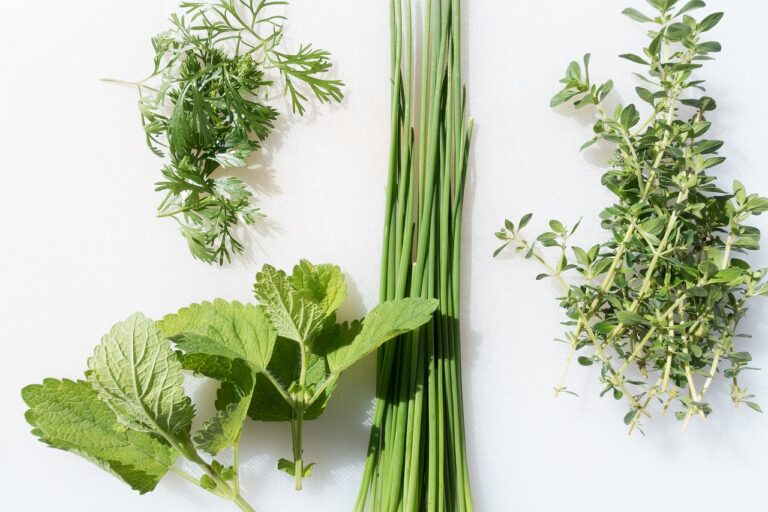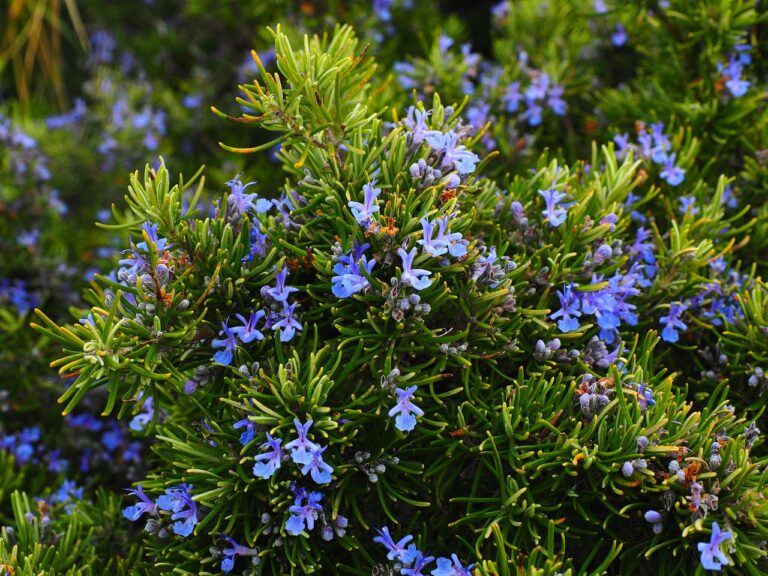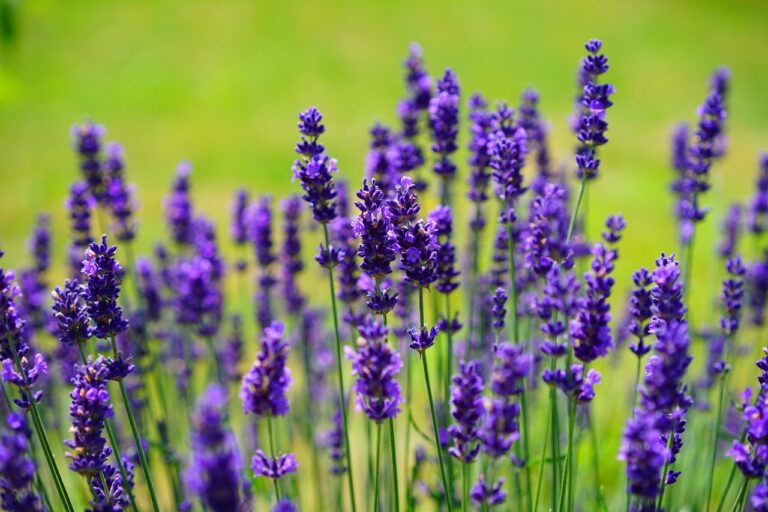Chives
I cultivate chives, part of Allium genus, because of their rich flavor and health benefits. Varieties include common chives, garlic chives, and Siberian chives. Common chives have blue-green leaves, while garlic chives offer a strong garlic-like taste. Make sure proper growing conditions for effective cultivation, including temperature and soil drainage. Chives, steeped in history from Roman times to modern usage, boast medicinal and culinary significance. Health benefits include vitamins A and C, antibacterial properties, and digestive support. Even in popular culture, chives make notable appearances. Keep exploring to uncover more about these versatile herbs.
Varieties of Chives
When exploring the varieties of chives, one encounters distinct characteristics that differentiate common chives, garlic chives, and Siberian chives. Common chives, scientifically known as Allium schoenoprasum, are the most widely grown and recognized. These chives typically feature small, slender bulbs and thin, blue-green leaves that are commonly used in culinary applications. On the other hand, garlic chives, or Allium tuberosum, are known for their flat leaves, white blossoms, and a stronger garlic-like flavor compared to common chives. These chives are a popular choice for adding a hint of garlic taste to various dishes. Siberian chives, or Allium nutans, are less common but equally intriguing. They boast blue-green foliage and can grow up to 2 feet tall, offering a taste profile similar to common chives.
When planting garlic chives, it is crucial to make sure the soil is well-draining and rich in organic matter. These chives thrive in fertile soil and benefit from regular watering, especially during dry spells. Adding compost or organic fertilizer to the planting area can promote healthy growth and improve the flavor of the chives. Additionally, garlic chives are relatively low-maintenance plants that can be grown in containers or directly in the garden, making them a versatile choice for home gardeners.
Culinary Uses of Chives
Chives, with their mild onion-like flavor, serve as an excellent flavor intensifier and garnish in a variety of culinary creations. Their delicate and grassy taste complements seafood, eggs, and creamy dishes harmoniously. Whether chopped over baked potatoes or blended into herb butter, chives add a fresh and aromatic touch to dishes.
Flavor Enhancer
In culinary applications, chives serve as a versatile and subtle flavor booster, adding a mild onion-like taste that complements a variety of dishes without overpowering their other flavors. The Allium nature of chives contributes to their distinct flavor profile, making them a popular choice in the kitchen. Here are some reasons why chives are valued as a flavor enhancer:
- Versatile Usage: Chives can be used in salads, soups, dips, and various other dishes.
- Balanced Flavor: They provide a mild onion-like taste that enriches the overall flavor without dominating it.
- Subtle Herbaceous Notes: The herbaceous flavor of chives adds a revitalizing touch to both cooked and raw dishes.
- Gentle Pungency: Chives enhance the taste of dishes without overwhelming them, making them a beloved herb in culinary preparations.
Garnish Option
Adding a delicate touch of color and flavor, chives are a popular garnish choice in culinary creations, enhancing both the visual appeal and taste of dishes. In terms of French cuisine, chives are often used as a finishing touch on classic dishes like potato soups and creamy sauces. Their mild onion flavor and vibrant green hue make them a perfect complement to a wide array of recipes. In companion planting, chives are valued for their ability to deter pests due to their pungent aroma. Chefs frequently opt for chives as a garnish due to their versatility and ability to add a pop of freshness without overwhelming the dish. Finely chopped, these fresh herbs provide a burst of flavor and a visually pleasing garnish.
Growing Chives
To cultivate thriving chives in your garden, ensuring they receive ample sunlight and well-drained soil is essential. When it comes to growing chives, attention to detail can make a significant difference in their development. Here are some practical tips to help you successfully plant and nurture your chives:
- Choose the right species: Whether you opt for common chives or garlic chives, selecting the appropriate species based on your climate and growing conditions is critical for a successful harvest.
- Planting depth and spacing: Plant chive seeds no more than ¼ inch deep in the soil, ensuring they are placed 2 inches apart. This spacing allows the plants to have ample room to grow and develop their root systems effectively.
- Temperature requirements: Chive seeds need temperatures between 60º and 70ºF to germinate successfully. Starting them indoors 6 to 8 weeks before the last spring frost can give them a head start in the growing season.
- Seasonal considerations: Chives are cool-season crops, thriving when planted in spring or fall. Consistent watering and occasional division of the plants are necessary for the best growth and longevity.
History of Chives
Cultivated in Europe since the Middle Ages, chives, scientifically known as Allium schoenoprasum, have a fascinating history filled with both culinary and medicinal significance. The Romans, recognizing the versatile nature of chives, utilized them not only for their flavor but also for their believed healing properties. They thought chives could help alleviate pain from sunburns and soothe sore throats. Additionally, the Romani people incorporated chives into their practice of fortune-telling, showcasing the diverse roles this herb played in ancient cultures.
Dutch farmers, known for their innovative agricultural practices, fed chives to their cattle. This unique feeding practice was not simply for sustenance but was believed to impart a distinct taste to the milk produced. The long history of chives spanning over 5,000 years showcases the enduring appeal and utility of this herb in various aspects of human life.
Over the centuries, chives have shifted from being mainly used for medicinal purposes to becoming a staple in culinary arts worldwide. Their rich history intertwined with different cultures and traditions highlights the enduring popularity and significance of chives in our daily lives.
Health Benefits of Chives
Chives, known for their rich content of essential vitamins and beneficial compounds, offer a wide array of health advantages. These slender green herbs not only improve the flavor of dishes but also contribute greatly to our well-being. Here are some key health benefits of chives:
- Rich in Vitamins: Chives are packed with vitamins A and C, important for maintaining a strong immune system and promoting healthy skin. These vitamins act as antioxidants, helping to protect our cells from damage caused by harmful free radicals.
- Antibacterial and Antifungal Properties: Chives contain allicin, a compound known for its antibacterial and antifungal properties. Consuming chives may help combat various infections and support overall health.
- Digestive Health: With low calories and high fiber content, chives aid in digestion and weight management. The fiber in chives promotes healthy digestion by supporting regular bowel movements and maintaining gut health.
- Heart Health Support: Regular consumption of chives may benefit heart health by assisting in lowering blood pressure and cholesterol levels. Chives are also a good source of antioxidants, which play an important role in reducing inflammation and decreasing the risk of chronic diseases.
Incorporating chives into your diet can be a flavorful and nutritious way to boost your overall health, particularly with regard to antioxidant intake and heart health maintenance.
Chives in Popular Culture
Chives have made appearances in various forms of popular culture, from movies to music and literature. Their distinct flavor and appearance have inspired creative minds to incorporate them into different art forms. Whether as a symbolic element in a movie scene, a poetic reference in a song, or a descriptive detail in a book, chives have left a lasting impression on popular culture.
Chives in Movies
Featured in culinary-themed films like ‘Julie & Julia’ and ‘The Hundred-Foot Journey,’ chives serve as aromatic and visually appealing additions to dishes, symbolizing freshness and sophistication in the art of cooking. In these movies, chives are highlighted for their role as a culinary herb, enhancing the overall presentation of meals. Here are some interesting points about chives in movies:
- Chives are used in cooking scenes to add flavor and visual appeal to dishes.
- ‘The Hundred-Foot Journey’ showcases chives as part of the diverse range of herbs and ingredients used in French and Indian cuisine.
- Chives symbolize freshness and sophistication in culinary settings, enhancing the visual and aromatic elements of dishes on screen.
- These herbaceous plants play a supporting role in conveying the artistry and attention to detail in food preparation depicted in these films.
Chives in Music
In the world of popular culture, chives make a remarkable appearance in music, adding a distinctive botanical touch to artistic expression. The song ‘Chives’ by The Growlers, featured in their album ‘Hung at Heart‘ released in 2013, stands out for its catchy tune and charming lyrics centered around the herb. This track showcases The Growlers’ signature style and diverse musical influences, enchanting fans with its playful references to chives. The band’s creative incorporation of chives in their song not only demonstrates their unique approach to music but also highlights the versatility of this herb in inspiring creative works. The Growlers’ ‘Chives’ is a delightful example of how everyday ingredients like chives can be transformed into poetic and entertaining musical pieces.
Chives in Literature
Investigating the domain of literature and popular culture, the understated presence of chives weaves a fragrant narrative, enriching various artistic expressions with its delicate allure and culinary symbolism. In literature, chives have been subtly mentioned in works ranging from Shakespearean plays to modern cookbooks, showcasing their enduring relevance in culinary arts and storytelling. Their delicate appearance and subtle flavor have inspired poets and writers to evoke vivid imagery and sensory experiences in their descriptions. Chives symbolize freshness and culinary finesse in many cultural references, illustrating their significance beyond the plate. Whether in poetry, prose, or recipes, chives continue to captivate audiences with their versatile use and botanical charm.
- Chives subtly mentioned in Shakespearean works and modern cookbooks
- Delicate appearance and subtle flavor inspiring poetry and descriptive writing
- Symbol of freshness and culinary finesse in cultural references
- Versatile use celebrated in various literary and culinary contexts





